Investor-owned electric utilities, their political action committees, and their executives have contributed millions of dollars to influence the outcome of gubernatorial races this election cycle in an attempt to maintain or increase their influence at state capitals. With forecasts predicting a potential blue wave, it wouldn’t be surprising if utility companies focused their campaign contributions on future Democratic governors. However, with some exceptions in blue and purple states, most utilities have doubled down on Republican leadership by continuing to pour money into GOP coffers, according to a review of campaign finance documents.
The Energy and Policy Institute analyzed various utilities’ campaign contributions aimed at gubernatorial elections in nine states: Arizona, Florida, Georgia, Illinois, Michigan, Nevada, New Mexico, Ohio, and Wisconsin. In several of these states with elected utility commissioners, EPI also highlighted how utility companies tried to influence the outcome of the elections of their future regulators.
EPI has also tracked how the utility industry has contributed to the Republican Governors Association and Democratic Governors Association, which are political organizations that must report their donors to the Internal Revenue Service.
RGA and DGA spend money in election years on advertisements to help candidates. In some instances, RGA or DGA gives its cash directly to state committees. For example, in September, RGA transferred a total of $750,000 to the Republican Party of Georgia, while DGA directed $550,000 to a PAC called A Stronger Ohio, which has run advertisements benefiting Democratic candidate Rich Cordray. RGA and DGA also provide forums for their corporate donors to meet privately with elected officials and their staff in an effort to influence or craft policy.
The electric utility industry’s combined contributions to RGA this cycle far outpaced their spending to help DGA: $4.1 million to $1.9 million. Top contributors to these political organizations are utilities that are also giving cash directly to candidates or state parties, such as Alliant Energy, Arizona Public Service and NextEra Energy.
States Where Utilities Support the Red Dam
Arizona: Pinnacle West and its CEO Support Doug Ducey While Fighting a 50% Renewable Energy Ballot Initiative
Arizona Public Service (APS) has spent $38,050 directly on Republican gubernatorial candidate Doug Ducey in this election cycle via contributions from its parent company Pinnacle West, as well as from Pinnacle West’s PAC.
Pinnacle West also gave $100,000 to the Republican Governors Association, which supports Ducey’s reelection.
Don Brandt, president and CEO of the corporation, has also given $22,500 to Ducey and his PAC. Neither the monopoly utility nor Brandt have spent on Democratic candidate David Garcia, who has rejected utility and corporate donations.
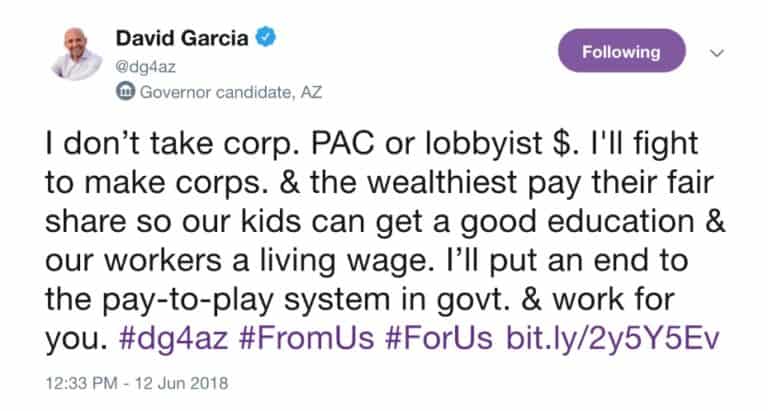
Pinnacle West has also donated substantially to the Arizona Republican Party this cycle. Various committees operated by the utility have donated a total of $480,500 has been directed to the state GOP. In September 2018, Arizonans for Sustainable Energy Policy gave $300,000 to the Republican Party. Pinnacle West is the sole contributor to Arizonans for Sustainable Energy Policy.
The utility has offered some support to the state’s Democratic Party, though it’s not clear how much. An Energy and Policy Institute review of the Arizona Democratic Party’s campaign finance reports filed this election cycle reveals only $2,000 from the Pinnacle West PAC ($1,000 on January 26, 2018 and $1,000 on July 25, 2017). Pinnacle West, however, reports in its Political Participation Policy for shareholders that the corporation itself contributed $50,000 to the party in 2017, contradicting those reports from the Party.
| Pinnacle West and its PACs | Don Brandt, CEO of Pinnacle West | |
| Arizona Republican Party | $480,500* | $0 |
| Arizona Democratic Party | $52,000** | $0 |
| Ducey Victory Fund | $0 | $17,750 |
| Arizona Leadership Fund (Doug Ducey) | $5,000 | $0 |
| Ducey For Governor | $10,200 | $5,100 |
| David Garcia | $0 | $0 |
*Includes the $300,000 Arizonans for Sustainable Energy contributed to the AZ GOP. Arizonans for Sustainable Energy has received contributions from only Pinnacle West.
**Takes into account $50,000 reported by Pinnacle West in its 2017 Political Participation report for shareholders, but not reported by the Arizona Democratic Party in financial disclosures.
APS also provided an unknown amount of funding for the “Arizona Education Project,” a non-profit organization founded in 2018 that ran $1 million in ads praising Ducey for the performance of Arizona’s public schools.
Additionally, the utility spent over $30 million, or 6% of its 2017 profits, in its effort to defeat a 50% renewable energy ballot initiative. The money has gone through the Arizonans for Affordable Electricity PAC.
The Arizona Corporation Commission (ACC), Arizona’s powerful 5-member board of elected utility regulators, has broad authority over the state’s energy policy. In 2014, Dark money groups spent more than $3 million on independent expenditures to help current ACC commissioner Tom Forese and former commissioner Doug Little get elected; APS has not confirmed nor denied being the source of that money. In 2016, APS spent openly on the ACC races by giving $4 million to a PAC which made independent expenditures to benefit current commissioners Bob Burns, Andy Tobin, and Boyd Dunn.
APS does not appear to have spent money thus far on the 2018 ACC races.
Florida: Putnam’s Defeat in Republican Primary Backfires on FPL, But Utilities Still Spend via Republican Governors Association
The four investor-owned utilities operating in Florida, along with their associated PACs, have spent a combined $12.8 million this election cycle. NextEra and its monopoly utility subsidiary, Florida Power & Light (FPL), was responsible for the bulk of the industry giving in the state, to the tune of $8.2 million.
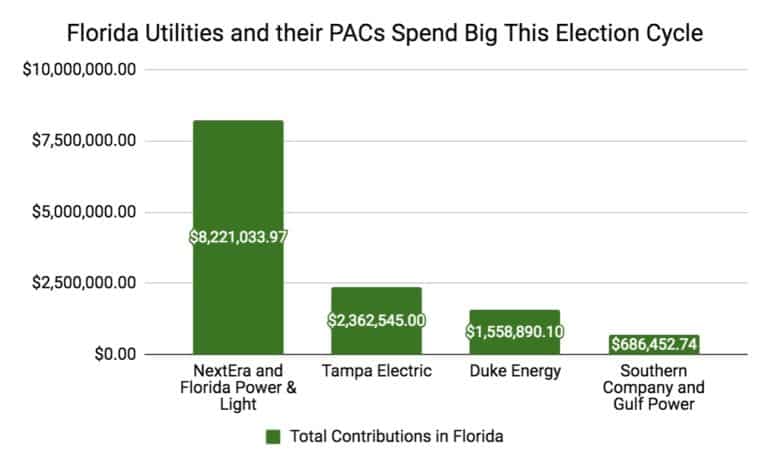
Utilities in Florida have largely backed Republicans, although not always in winning contests. FPL contributed more than a half a million dollars directly to the PAC of Adam Putnam, the establishment Republican candidate for governor who lost his primary battle with Ron DeSantis.
Florida Democratic candidates have received few contributions from utilities and have generally taken a harder line against accepting utility money. Andrew Gillum, the Democratic nominee for governor, signed the No Fossil Fuel Money Pledge. Signers of the pledge promised not to accept contributions from utilities that generate 50% or more of their electricity from fossil fuels, which includes two cornerstones of the Florida political establishment: NextEra and Duke Energy. Southern Company, current owner of Gulf Power, is also on the prohibited list, though it is selling Gulf Power to NextEra due to financial pressures.
The Florida utilities have directed most of their spending to PACs controlled by Associated Industries of Florida (AIF), the state’s main industry lobby group. After passing through those PACs, the utility contributions filter down to other PACs and political firms, almost all of which have spent money to benefit Republican candidates. For example, the five largest expenditures made by the AIF-affiliated Voice of Florida Business PAC, which is the largest recipient of utility money, went to Putnam’s Florida Grown – totalling more than $1 million in contributions.

Last year, The Wall Street Journal revealed that in 2014, FPL donated $1.6 million to the Republican Governors Association, mostly in September. RGA then transferred $1.5 million to a Republican political group to aid Gov. Rick Scott’s reelection. FPL had been seeking approval for a natural gas pipeline and rate increases from the Scott-appointed PSC.
This election cycle, utilities operating in Florida along with their parent companies have contributed over $2 million to RGA and less than $500,000 to DGA. As in 2014, NextEra contributed $950,000 of its $1.5 million to RGA in September 2018: $700,000 on September 13 and $250,000 on September 26. RGA then transferred $1 million to Friends of Ron DeSantis on September 28.
| NextEra Energy | Duke Energy | Southern Company | Tampa Electric | |
| Republican Governors Association | $1,516,639 | $295,000 | $205,769 | $5,000 |
| Democratic Governors Association | $190,000 | $75,000 | $202,200 | $0 |
The Florida utilities’ contributions to the state GOP have largely paid off in recent years, as the state has been under Republican control. Last year, a report released by Integrity Florida, a non-profit independent research institute, detailed how Florida utilities influence the Governor and the Legislature through political contributions and lobbying, and have used that influence to “pursue favorable regulatory decisions by the PSC, at the expense of the public.” Integrity Florida concluded that the utilities increased their influence over the PSC after then-Democratic Governor Charlie Crist’s PSC appointments voted against a FPL $1.3 billion rate increase. Since then, commissioners appointed by Scott have approved utility-friendly policies, including granting rate increases to FPL and gutting energy efficiency standards.
The next governor of Florida will have the opportunity to reshape the PSC by appointing several of the regulators during his first term in office. It is unclear if Scott will be able to appoint a replacement for Commissioner Julie Brown, whose term ends on January 1, 2019, which is just days before the next governor is sworn into office on January 8, 2019. The same situation will occur in January 2022 when the terms of Commissioners Art Graham and Andrew Fay expire.
Georgia: Donors with ties to Southern Company Back Republican Incumbent Public Service Commissioners as Vogtle Pressure Mounts
Two seats on the Georgia Public Service Commission, District 3 and District 5, are up for re-election. Republican Chuck Eaton holds the District 3 seat, and Republican Tricia Pridemore, who was appointed to the position by Republican Governor Nathan Deal in February 2018, holds the District 5 seat. Eaton ran unopposed in the primary and Pridemore squeezed out a victory over challenger John Hitchins, who criticized Pridemore for being too close with Georgia Power.
Georgia Power, the sole investor-owned electric utility in Georgia and a subsidiary of Southern Company, has not given directly to either candidate, but it has influenced the election by proxy.
Eaton and Pridemore’s campaign contributions from entities affiliated with the companies they are charged with regulating have been a central issue in the campaign due to the concerns about the over-budget and delayed Vogtle nuclear project.
Eaton and Pridemore have received over $100,000 in this election cycle from people or companies associated with Southern Company. Most questionable contributions have come from Southern Company subsidiaries like Southern Company Gas, or law firms that represent Georgia Power, such as Troutman Sanders.
% of Campaign Contributions Associated with Regulated Entities – District 3
| June 30th, 2018 Filing | Sept. 30th, 2018 Filing | |
| Chuck Eaton (R) – Incumbent | 23% | 57.5% |
| Lindy Miller (D) | 3.4% | 7.4% |
| Ryan Graham (L) | 0% | 0% |
% of Campaign Contributions Associated with Regulated Entities – District 5
| June 30th, 2018 Filing | Sept. 30th, 2018 Filing | |
| Tricia Pridemore (R) | 40% | 16.4% |
| Dawn Randolph (D) | 0% | 0% |
| John Turpish (L) | 0% | 0% |

Paul Bowers, Chairman, President and CEO of Georgia Power, contributed $5,000 to Brian Kemp in his race against Stacey Abrams.
Southern Company and Georgia Power also donate to the state’s political parties, favoring Republicans by a ratio of 11:1 ($257,500 contributed to the GOP; $23,000 contributed to Democrats).
Southern Company and Georgia Power also kicked in $25,000 to the Georgia House Republican Trust and $26,000 to the Georgia Republican Senatorial Committee, which contribute directly to Republican candidates in each respective chamber.
Although Georgia’s governor does has not been a major player in the state’s energy policy in recent years compared to the PSC, Georgia Power CEO Paul Bowers contributed $5,000 to the Republican gubernatorial nominee Brian Kemp in his race against Stacey Abrams.
Wisconsin: Utilities Stand With Walker
Wisconsin utilities and their executives have contributed thousands of dollars to Scott Walker and none to the Democratic nominee Tony Evers this election cycle.
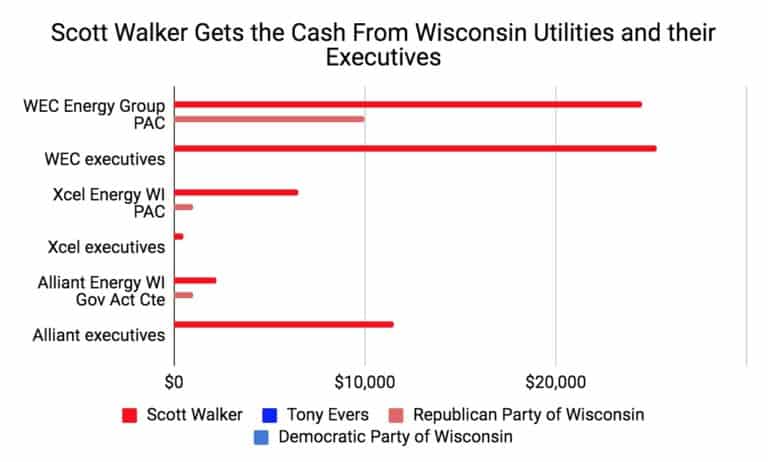
But unlike their neighbors in Michigan and Illinois, where utilities’ PACs and executives have contributed to both Democrats and Republicans in anticipation of a change in political power, Wisconsin power companies have stood by Walker. That may be a risky bet: the election forecasters at FiveThirtyEight give Evers a 3 in 5 chance of winning.

Gale Klappa, Chairman and CEO of WEC Energy, contributed $10,000 to Scott Walker
Gale Klappa, chairman and CEO of WEC Energy Group, contributed $10,000 to Walker in March. Alliant Energy CEO Patricia Kampling recently contributed $2,500 to Walker, bringing her total contributions to the Republican candidate to $5,500. Alliant Energy has also contributed a total of $105,450 to RGA this cycle.
Energy issues haven’t played a significant role in the gubernatorial debates. But when climate change was discussed in the final debate, Evers said he’d prioritize renewable energy development while Walker continued to use what has become a standard climate denial talking point, saying that “it’s a combination of things, and the actions of human beings are one piece of a larger puzzle.”
In an interview with 350 Madison earlier this year, Evers said that fossil fuel pollution is a problem in southeast Wisconsin and suggested that Foxconn should install solar panels on its buildings in that area to help offset the increase in electricity demand it is causing. Foxconn is constructing a $10 billion factory park manufacturing liquid-crystal display panels, or LCDs. The area is also home to the 1,135 megawatt We Energies-operated Oak Creek coal power plant. The coal plant has been in the news over the past year as residents have complained that the utility hasn’t done enough to solve a coal dust problem that has been ongoing for years.
If Evers defeats Walker, he will have the opportunity to appoint one regulator to the Public Service Commission, subject to confirmation by the Wisconsin Senate. The Wisconsin PSC is a three-person body.
States Where Utilities Hedged Their Bets
Michigan: After Backing Schuette, DTE Energy and CMS Energy Leadership Hop on the Whitmer Bandwagon
The political action committees for the two largest investor-owned utilities in the state, Consumers Energy and DTE Energy, have stayed relatively quiet in the state’s 2018 gubernatorial election. Through October 26, only the Consumers Energy employees PAC contributed to one of the candidates, and that was over a year and a half ago when it contributed $5,000 to Bill Schuette’s attorney general campaign committee in April 2017. After months of speculation, Schuette officially declared his candidacy for governor in September 2017. He was able to transfer funds out of his attorney general campaign and into his campaign for governor.

Patricia Poppe, CEO of CMS Energy, contributed $6,800 to Bill Schuette
When Schuette did officially declare, his campaign committee was inundated with cash. Numerous executives and lobbyists, including both of the utility’s CEOs, Patti Poppe of CMS Energy and Gerard Anderson of DTE Energy, were quick to support Schuette. A variety of executives and leadership from CMS and DTE have contributed a total of $88,450 to Schuette – $37,625 of which came in the first days of Schuette’s official launch. Poppe contributed the maximum of $6,800 on September 8, 2017, while Anderson contributed $2,000 of his $4,500 total to Schuette on that day.
But a lot has changed since September 2017.
Gretchen Whitmer emerged as the Democratic nominee and polls and forecasts from earlier this year showed her pulling away from Schuette. Leaders and lobbyists for the two utility companies had already begun to ramp up their campaign contributions to Whitmer, likely seeing the writing on the wall. Whitmer’s campaign has now received a total of $59,300 from these individuals – $44,800 since the start of May 2018. Whitmer declared her candidacy in early January 2017.
DTE’s Anderson contributed $2,500 to Whitmer’s campaign on May 4, 2018, and then another $2,500 on October 17, 2018. CMS’ Poppe has not contributed to Whitmer.
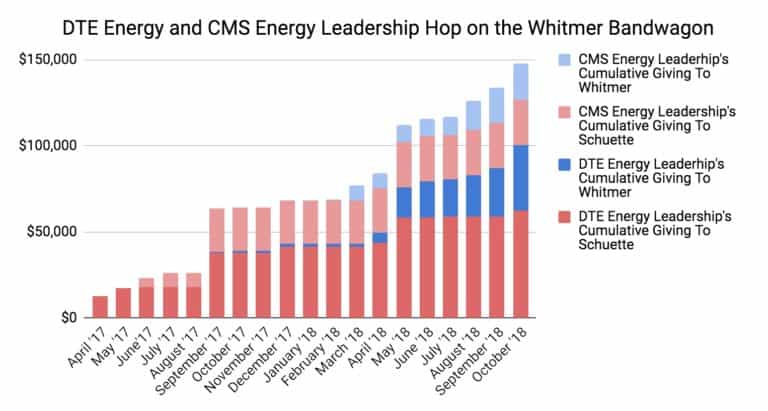
While energy issues haven’t risen to significant prominence in the gubernatorial debates, the winner in November will have a major impact on the utilities over the course of his or her term in office. The new governor will have the ability to appoint two new commissioners to the three-member Public Service Commission in their first term alone. Gov. Rick Snyder received criticism in 2015 for selecting former Consumers Energy lobbyist Norm Saari to fill a PSC vacancy. Consumers Energy was a top contributor to Snyder’s Moving Michigan Forward PAC.
The MPSC will rule on a variety of controversial energy issues, including when to close the Michigan utilities’ coal generation fleet and what should replace that power; the value of distributed rooftop electricity; how third-party renewable energy providers can develop large-scale solar in the state; the number of customers allowed to choose their own power provider; electric vehicle initiatives; and electric and natural gas rates.
Nevada: NV Energy Spends $60 Million to Keep its Monopoly, Spends on Sisolak, Hedges with Laxalt via other PACs
At first blush, Nevada’s monopoly utility, NV Energy, appears to have fully backed Steve Sisolak, the Democratic nominee for governor. The utility gave $20,000 to him and only $2,000 to Republican gubernatorial candidate Adam Laxalt. NV Energy made its contribution to Laxalt’s Attorney General committee before he had officially declared his intention to run for governor.
The utility also has given $80,000 to the state’s Democratic party and nothing to the state’s Republican party during this election cycle.
However, NV Energy has provided cash to at least one PAC that has supported Laxalt; the BizPAC, which is affiliated with the Las Vegas Metro Chamber of Commerce. NV Energy provided a total of $20,000 to the BizPAC this cycle, and on September 17, 2018, the BizPAC contributed $10,000 to Laxalt For Nevada.

RGA Nevada TV Ad: “Expensive” (Source: YouTube)
Berkshire Hathaway Energy, the parent company of NV Energy along with other rate-regulated utilities in nearly a dozen states, contributed a total of $150,400 to RGA this cycle and nothing to DGA. RGA has launched TV advertisements in Nevada attacking Sisolak and his votes on tax issues. RGA also transferred $10,000 to Laxalt For Nevada in July.
Nevertheless, NV Energy’s direct contributions to Sisolak may owe in part to one of the major energy initiatives that voters will decide on election day that threatens NV Energy’s monopoly: Question 3.
Question 3, also known as the Energy Choice Initiative, calls for a competitive retail energy market (deregulation) and would break up the monopoly that NV Energy currently has. Sisolak is against the initiative while Laxalt supports its passage. NV Energy has contributed over $63 million to the Coalition To Defeat Question 3 PAC this campaign cycle in its attempt to defeat the measure after the utility remained neutral two years ago when an earlier version passed. (Ballot measures must pass in two consecutive cycles to become law in Nevada.)
Nevada voters will also decide Question 6, which would require utilities to source half of their electricity from renewables by 2030. NV Energy has not taken a stance on the measure, but Sisolak supports it. Laxalt has not taken a direct position but is against “efforts to impose or expand costly and burdensome mandates on energy providers.” The current RPS in Nevada is 25% by 2025. If voters pass Question 6 in November, they would also have to approve it in the 2020 election for the initiative to become law.
New Mexico: Largest Utility in the State Gives Max to Both Candidates, while CEO Backs Democrat
PNM Resources, New Mexico’s largest investor-owned utility, contributed the maximum amount of money allowed by state law to both Republican Steve Pearce and Democrat Michelle Lujan Grisham. CEO Patricia Collawn, however, focused her contributions solely on Lujan Grisham. Collawn contributed $5,500 to the campaign in May while Patrick Apodaca, senior vice president and general counsel for the utility, contributed a total of $2,500.
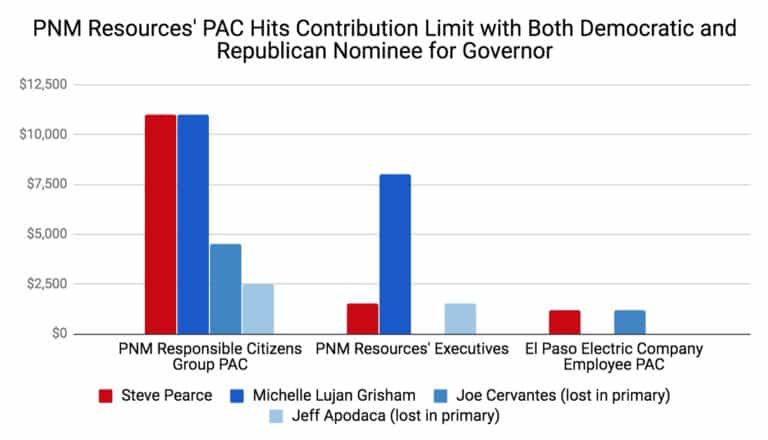
In an interview earlier this year with New Mexico Political Report, Grisham said she intends to move the state to adopt a 50% renewable energy standard by 2030 and an 80% standard by 2040.
Grisham later said in the interview:
My God, we have 300 sunny days [a year]. We could lead in clean energy production. If you look at job growth, it outpaces by far in renewables than it does in oil and gas, even though oil and gas still has a larger employment footprint in the state. It’s because we failed to make investments here. That means we have failed New Mexico families who could have high-paying productive jobs, and we haven’t protected the environment. It makes no sense.”
New Mexico also elects its own utility regulators, the Public Regulation Commission (PRC).
Ahead of the PRC primary, PNM spent $440,000 through a PAC called New Mexicans For Progress. According to the Santa Fe New Mexican, the PAC then used the PNM money to promote two Democratic incumbents running in their respective primaries. Those incumbents, which regulate PNM, were Lynda Lovejoy and Sandy Jones. Environmental groups said the two regulators have been too friendly and deferential to the utility industry.
Despite PNM’s efforts, both incumbents lost.
Theresa Becenti-Aguilar defeated Lovejoy in the District 4 Democratic primary and will win election to the PRC, since she is running unopposed in the general election. Jones lost to Stephen Fischmann, who faces Republican Ben Hall.
As in other states, the PRC regulates utility rates, determines the value of distributed solar energy, and must give utilities permission before they build new infrastructure.
Ohio: Utility PACs Power Republican Mike DeWine’s Campaign, Lobbyists Hedge
Five PACs affiliated with American Electric Power, Dayton Power & Light, Duke Energy, FirstEnergy, and the state’s rural electric cooperatives doled out over $1.2 million in state-level campaign contributions in Ohio since the start of 2017.
FirstEnergy led the pack with more than $470,000 in campaign contributions. AEP followed with over $305,000 in campaign contributions, while the Ohio Action Committee for Rural Electrification (ACRE) contributed over $255,000.
Republican candidate for governor Mike DeWine pulled in campaign contributions from all five utility PACs, totaling nearly $64,000 this cycle. FirstEnergy gave the most money – over $25,000 – to DeWine. Richard Cordray, the Democratic candidate for governor, received a $5,000 campaign contribution from Dayton Power & Light.
Charles E. Jones, the CEO of FirstEnergy Corporation, also made an in-kind contribution of “event food and beverage” valued at $12,700 to DeWine’s campaign.
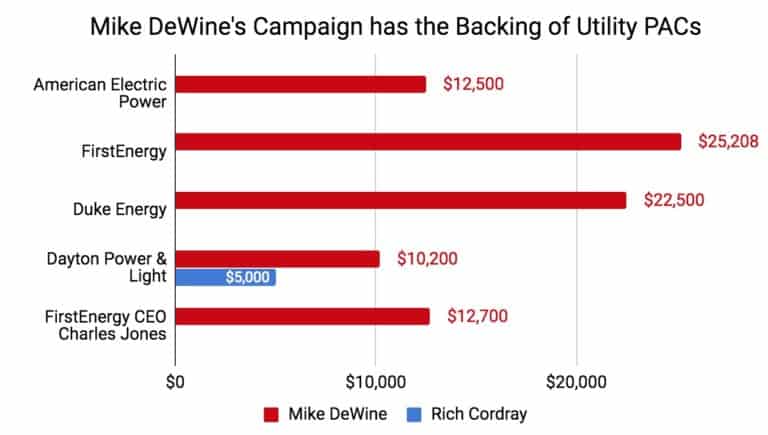
However, lobbyists employed by FirstEnergy have also contributed to Cordray, as well as to DeWine’s campaign. In fact, Cordray received a total of $3,000 in campaign contributions in October from executives and staff at the Dewey Square Group, which FirstEnergy Solutions hired to “provide management of an advocacy campaign in support of legislation related to nuclear energy in Ohio and Pennsylvania…” Cordray also received thousands of dollars in campaign money last month from Akin Gump lobbyists and attorneys, including several employed by FirstEnergy Solutions. FirstEnergy hired Akin Gump earlier this year to serve as legal counsel and to help lobby for bailouts to FirstEnergy’s coal and nuclear plants.
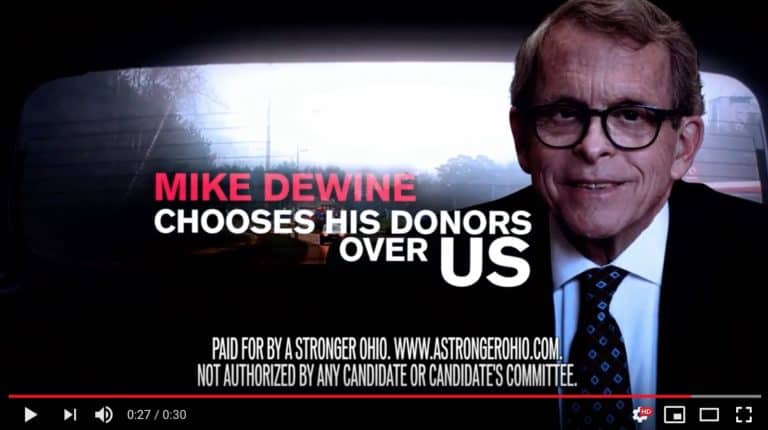
A Stronger Ohio, an independent organization is backed by the Democratic Governors Association. (Source: YouTube)
FirstEnergy has also contributed $102,500 to DGA and $65,000 to RGA. DGA used the cash from its donors to direct $550,000 to a PAC called A Stronger Ohio. The PAC recently launched a new advertisement.
Cordray and DeWine have both voiced support for efforts to bail out nuclear power plants owned by FirstEnergy’s now bankrupt subsidiaries, a move opposed by Ohio’s current governor John Kasich. AEP, Dayton Power & Light, Duke Energy, and Ohio’s Electric Cooperatives have also lobbied state lawmakers for bailouts for coal-fired power plants.
The governor also plays a key role in appointing new commissioners to the Public Utilities Commission of Ohio (PUCO). Four of the five current commissioners will have their terms end during the next governor’s four-year term. Cordray or DeWine will select commissioners from a list provided by a nominating committee, and then that individual must be confirmed by the Ohio Senate.
PUCO has faced requests from utilities like AEP to hike monthly fixed fees paid by consumers, and has also received criticism for approving consumer-funded bailouts for coal and nuclear plants proposed by AEP and FirstEnergy in decisions that were later overturned by the Federal Energy Regulatory Commission.
State Where Utilities Want To Ride The Blue Wave
Illinois: Ameren, ComEd and Exelon Join the Blue Wave, But Still Hedge With PAC Contributions to the GOP
Democrat multi-billionaire J.B. Pritzker and Republican Bruce Rauner, whose net worth is believed to be $500 million, are self-funding their gubernatorial campaigns. Illinois’ utilities, their executives, and their respective PACs, therefore, haven’t directly contributed funds to candidates’ committees. But Exelon and its subsidiary ComEd, along with the Southern Illinois utility Ameren, have still voiced their support for political candidates and parties via campaign donations this cycle.
In a state that is largely Democratic but sent a Republican governor to Springfield in 2014 for the first time since 1999, the utilities likely assumed that the Democratic Party would again regain control. Indeed, Pritzker has been ahead by double digits in the polls since forecasts began to emerge over a year ago.
The utilities’ PACs and the companies themselves have contributed a total of $159,100 to the Democratic Party of Illinois Committee, while contributing only $74,700 to the Illinois Republican Party Committee.
The Democratic party committee, in addition to spending on behalf of statewide candidates, has transferred funds to the Pritzker campaign. Vistra Energy (formerly Dynegy) has also contributed a total of $10,000 to the Democratic party this election cycle. Vistra operates 12 fossil fuel generating stations in Illinois, which has a deregulated power market.
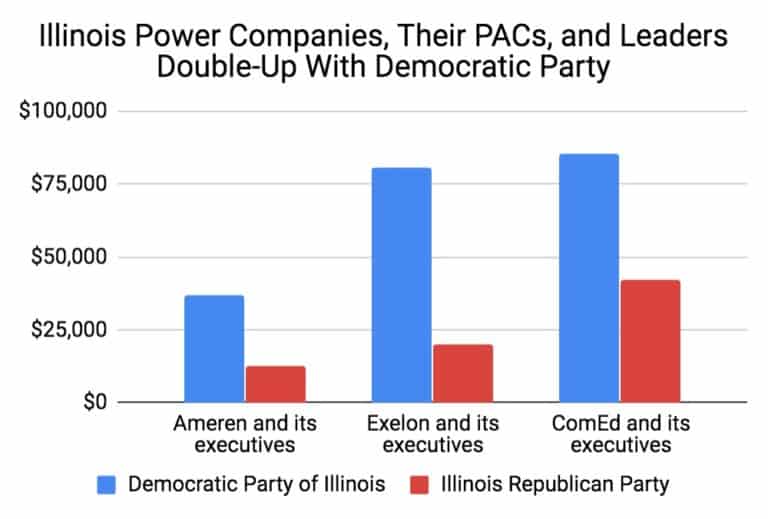
The utility companies have also contributed to the national political organizations focused on governors. Exelon gave $150,000 to the DGA. Ameren has allocated $25,000 to RGA, while Vistra has donated $50,000 to both.
Governor Rauner signed the Future Energy Jobs Act (FEJA) at the end of 2016. FEJA set ambitious energy efficiency goals, made repairs to the state’s 25% by 2025 renewable energy standard, created a funding mechanism to keep two Exelon nuclear plants in operations, and opened up a market for community solar. The next governor will have the opportunity to appoint three regulators to the five-member Illinois Commerce Commission, the agency that oversees utilities and sets their rates.
Illinois’ next attorney general will also have a direct effect on the utilities. The utilities have had numerous battles with current Attorney General Lisa Madigan, and when Madigan announced that she would not run for re-election in 2017 after serving as the state’s highest legal officer since 2003, the utilities pulled out their checkbooks in an effort to curry favor with her successor.
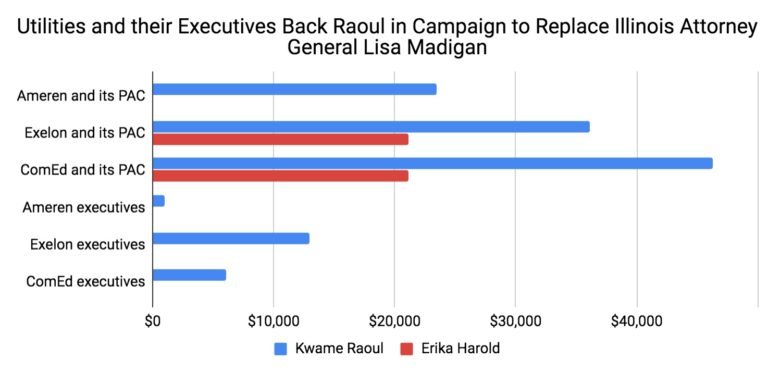
The utility companies and their PACs have contributed a total $148,050 to the nominees from both parties, Democrat Kwame Raoul and Republican Erika Harold. Of that total amount, the utilities directed $105,850 to Raoul.
Executives at the utilities have also largely endorsed Raoul as they have contributed a total of $20,100 to Raoul’s campaign.


[…] publicly report their donors, while 501(c)(4)s do not. The Energy and Policy Institute reported on FirstEnergy Corp. and FES’s contributions to the RGA and DGA in 2018, based on publicly available reports those […]